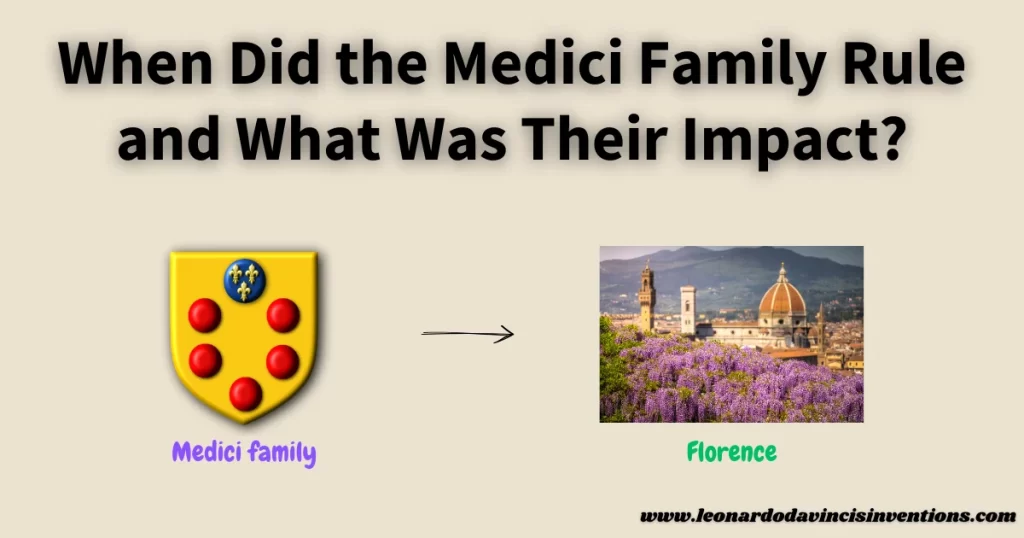
When Did the Medici Family Rule? This question often arises in world history, particularly for those interested in the origins of the Renaissance.
If you have ever wanted to know how a single family shaped the culture and politics of Florence for centuries, you are not alone.
This post will help you learn the key dates of Medici power and why their influence still matters.
The Medici family ruled Florence and later Tuscany from 1434 to 1737, with only short interruptions.
Their leadership turned Florence into a center of art, science, and banking during this long period.
The Medici supported famous artists like Michelangelo and Leonardo da Vinci.
They left a lasting mark on history through their contributions to both government and culture.
Their rise to power started with Cosimo de’ Medici, who built the family’s fortune through banking.
Later members, such as Lorenzo the Magnificent and Catherine de’ Medici, became important leaders in Florence and across Europe.
To understand the Medici family‘s origins and enduring influence, it is essential to examine their political rule and its impact on the arts and sciences.
How Long Did the Medici Family Rule and Establish Their Power in Florence and Tuscany
The Medici family controlled Florence and later Tuscany for centuries.
They shaped politics, society, and the arts, ranging from financial innovation to leading the city’s cultural golden age.
Origins of the House of Medici and Their Rise as a Banking Family
The House of Medici began as an Italian bourgeois family in Florence.
Early members gained prominence in the 13th and 14th centuries through their involvement in commerce and banking.
The Medici bank became one of the most successful financial institutions in Europe.
The success of the Medici banking family allowed them to accumulate substantial wealth and gain significant social influence.
Their financial power led to important alliances with the church and key European leaders.
Using loans and investments, they supported the papacy and secured lucrative contracts.
Their financial operations helped lay the groundwork for their later political rise.
The Medici name became respected not just in Florence but across Renaissance Italy.
Their coat of arms began to appear at important public and private buildings.
Cosimo de’ Medici’s Role in Shaping Florence’s Political Leadership
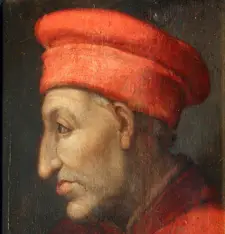
Cosimo de’ Medici, known as Cosimo the Elder, was the family’s first great political leader.
In the early 15th century, he transformed the Medici from wealthy bankers into de facto rulers of Florence.
Cosimo used his wealth to build loyalty networks among Florence’s leading families and the public.
He controlled elections and key decisions from behind the scenes.
Cosimo avoided official titles but held real power as Florence’s leading citizen.
His approach provided Florence with stability and contributed to the city’s prosperity.
He patronized artists and humanists, launching the Medici legacy as a prominent patron of the arts.
Under Cosimo’s influence, Florence entered its golden age.
The Medici Family Rule from 1434 to 1737: A Timeline Overview
The Medici ruled Florence almost uninterrupted from 1434 to 1737, with a few periods of exile and restoration.
For nearly 300 years, they protected and shaped the region’s political and cultural life.
Key Dates Table:
| Year | Event |
|---|---|
| 1434 | Cosimo de’ Medici seizes power |
| 1494–1512 | Medici exile from Florence |
| 1512 | Medici restoration |
| 1527–1530 | Second period of exile |
| 1537 | Cosimo I becomes Duke of Florence |
| 1569 | Appointment as Grand Dukes of Tuscany |
| 1737 | Death of Gian Gastone de’ Medici |
During exile periods, Florentines restored the republic, but Medici supporters often engineered comebacks.
The dynasty ended with Gian Gastone de’ Medici’s death in 1737, after which the family line came to an end.
Florence Republic to Grand Duchy: Evolution of Medici Governance
Florence was originally a republic, but the Medici shifted the city’s government over time.
Through both soft power and legal changes, they faded out the republic’s functions and concentrated authority.
Cosimo I de’ Medici completed this shift.
He was named Duke of Florence in 1537 and became Grand Duke of Tuscany in 1569.
Medici rulers granted themselves new rights, controlled the armed forces, and built grand palaces.
The title of Grand Duke helped the Medici family legitimize their dynastic rule.
The political landscape of Florence and all of Tuscany underwent significant changes, resulting in new governance structures and increased central control.
Medici Wealth and Influence in 15th and 16th Century Renaissance Italy
The Medici family’s wealth, particularly in the 15th and 16th centuries, enabled them to patronize artists, architects, and scholars.
Their patronage system supported figures like Michelangelo, Botticelli, and Galileo.
Medici’s contributions to art and culture made Florence a center of the Renaissance.
They sponsored public works, libraries, and scientific research, leaving a long-lasting legacy.
Their power extended through marriage alliances, papal relatives, and strategic appointments.
The Medici influence in politics and culture profoundly shaped Renaissance Italy, helping to establish Florence as a cultural and artistic leader.
The Medici Family’s Cultural Impact and Political Power During the Renaissance
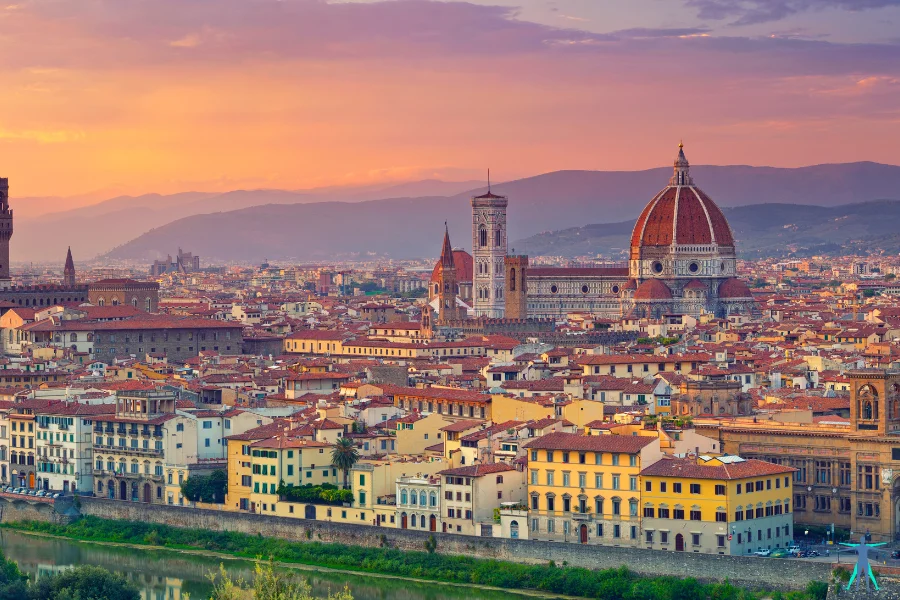
The Medici family transformed Florence’s political landscape, making the city a leading force in Renaissance Italy.
Through banking, patronage, and political maneuvering, the Medici gained vast influence over art, religion, and government.
Lorenzo de’ Medici and the Patronage of the Arts in Florence’s Golden Age
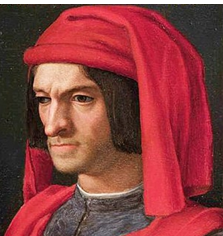
Lorenzo de’ Medici, known as Lorenzo the Magnificent, led Florence during its golden age in the late 15th century.
Under his leadership, the city became a major center for culture, learning, and creative innovation.
Lorenzo supported artists like Michelangelo and Leonardo da Vinci, commissioning public works and private masterpieces.
Florence flourished under Lorenzo’s patronage of the arts.
Artists, writers, and philosophers gathered at his court, shaping Western culture for centuries.
His investments made Florence not only wealthy but also influential across Europe.
Lorenzo’s influence helped the city emerge as a cultural heart of the Renaissance and a beacon for future generations.
Medici Contributions to Art and Culture Through Their Patronage System
The House of Medici established a patronage system that profoundly influenced art and culture in Florence and beyond.
Members of the dynasty paid leading artists to decorate chapels, paint portraits, and create sculptures.
They financed the construction of famous landmarks, including Florence Cathedral, and helped fund Saint Peter’s Basilica in Rome.
This support allowed artists to experiment and push artistic boundaries.
Painters like Botticelli and Donatello thrived under Medici sponsorship.
Their projects left a lasting mark on Renaissance Italy, setting standards for beauty and skill that influenced all of Europe.
The Medici patronage system turned Florence into an international center for high art and creativity.
Medici Popes and Their Influence on Religion and Politics
Several family members became Medici popes, including Leo X and Clement VII.
Their roles significantly expanded the Medici’s influence in religious and political affairs.
Leo X, for example, used his position to commission major works of art and architecture for the Vatican.
Medici popes shaped the Catholic Church’s policies during the turbulent 16th century.
They played a part in the Reformation’s response and increased the family’s clout over European politics.
These popes strengthened ties between Florence and Rome, helping secure the Medici family’s status in Italian and international history.
The Medici Bank’s Role in Consolidating Family Wealth and Power
The Medici bank, started in the 14th century, became one of Europe’s most powerful banking families.
Its branches stretched across Italy and other parts of Europe, including London and Bruges.
The Medici built great wealth through careful management, enabling them to fund political ambitions and art projects throughout the 15th and 16th centuries.
Their financial strength gave them control over the Florence government and allowed them to lend money to kings and popes.
This banking success also protected the Medici during periods of political exile, making their rule possible even after they faced power struggles and threats from rival families.
Medici Family Legacy: Patrons of Artists and Renaissance Cultural Impact
The Medici legacy is inextricably linked to their contributions as patrons of artists and leaders in the Renaissance.
Through their investments in art, architecture, and education, the Medici significantly influenced European culture long after their rule ended in 1737 with the death of Gian Gastone de’ Medici.
Their coat of arms still adorns significant places in Florence, such as the Medici Palace.
Key works by Michelangelo, Botticelli, and others reflect the Medici family’s priorities and taste.
Today, Florence’s museums and churches house many of these treasures, which, as noted here, remind us of the profound impact of the Medici dynasty on art, culture, and political leadership during one of the most pivotal periods in history.
Why Did the Medici Family Rule End? Decline, Exile, and Succession Challenges
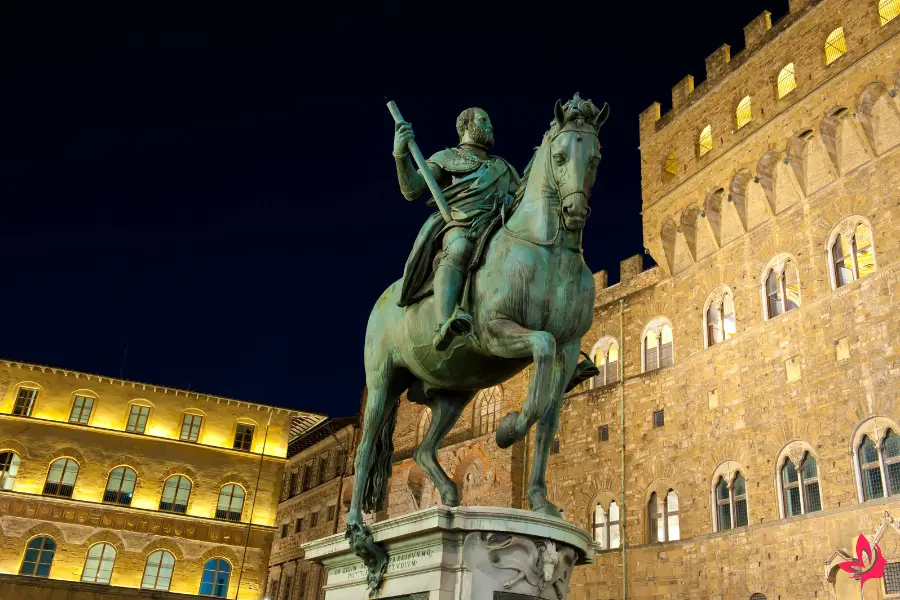
The Medici family ruled Florence from 1434 to 1737, experiencing periods of strong leadership, exile, attempted resurgence, and ultimately extinction.
The dynasty’s end came after internal political conflict, challenges to their power, economic decline, and the failure of the last Medici ruler to produce an heir.
Political Power Struggles and Medici Exile Periods (1494-1512 and 1527-1530)
The House of Medici faced intense power struggles in the late 15th and early 16th centuries.
After Lorenzo de’ Medici died in 1492, Florence’s people grew tired of one family’s rule.
In 1494, the Medici were expelled as foreign armies invaded Tuscany, and political opposition increased.
They lived in exile until 1512, when Spanish forces helped restore their power.
Another revolt in 1527 forced the Medici into exile again.
These periods of absence weakened their influence and made the Florentine Republic more unstable.
Restoration in 1530, with Charles V’s help, marked the Medici’s shift from banking family to hereditary rulers as Grand Dukes of Tuscany.
The Role of Gian Gastone de’ Medici and the Final Succession Crisis
Gian Gastone de’ Medici became Grand Duke in 1723. He represented the last of his lineage.
He had no children and lacked support from powerful allies. Gian Gastone faced pressure over who would succeed him in Tuscany.
His poor health and unpopular court hurt the Medici’s image even more.
When Gian Gastone died in 1737, the Medici family had no legitimate heir, creating a succession crisis in Tuscany.
Foreign powers, mainly the Austrian Habsburgs, took control of Tuscany through political agreements. The Medici family tree ended with Gian Gastone, formally closing the chapter on one of Europe’s most famous dynasties.
Medici Family Downfall: Declining Wealth and Influence in the 17th Century
During the 17th century, the Medici family’s economic base eroded. Their once-powerful Medici bank closed, cutting their revenue and weakening their European influence.
Trade and banking rivals in other states surpassed Florence’s influence. This shift shrank the Medici family’s power.
Extravagant spending on the arts and court expenses drained Medici wealth. Their finances dwindled, and they struggled to support artists and public projects.
This financial decline reduced their hold over Florence politics. The family became vulnerable to outside intervention.
Attempts at Medici Restoration and the End of the Dynasty in 1737
After each exile, members of the Medici family attempted to regain leadership in Florence. Cosimo I restored strong Medici control and transformed the role from civic leader to hereditary Grand Duke.
Later attempts to restore the Medici were less successful. The family struggled to maintain heirs.
After Gian Gastone’s death, no recognized Medici remained. By agreement among Europe’s leading powers, Tuscany passed to Francis Stephen of Lorraine, marking the end of approximately 300 years of Medici rule.
The Medici coat of arms and other symbols remained in Florence, but lost their political significance.
The Lasting Medici Legacy in Florence’s Government and Cultural History
Although the Medici family lost political power, their impact on art, science, and government in Florence endures. They established the Medici patronage system and supported artists such as Michelangelo and Leonardo da Vinci.
Their promotion of the Renaissance made Florence a leading cultural center in Italy. Medici contributions also shaped Florence’s government through the introduction of new laws and the construction of public buildings.
Landmarks such as the Medici Palace and grand artworks reflect their legacy today. The Medici defined an era of prosperity and creativity in Tuscany.
Frequently Asked Questions
The Medici family’s rise to power in Florence profoundly shaped art, politics, and banking for centuries. Their leadership left a lasting impact on Italy’s culture, power struggles, and royal families.
When did the Medici family gain power?
The Medici family started gaining power in Florence in the early 15th century. Cosimo de’ Medici took control in 1434, marking the beginning of the Medici family’s long influence in the city.
Their power stemmed from their success in banking and astute alliances with other political groups.
Who was the last Medici to rule Florence?
Anna Maria Ludovica de’ Medici was the last official member of the Medici family. She died in 1743, ending the Medici rule in Florence.
The family controlled most of the city’s affairs until the mid-18th century.
What was the legacy of the Medici family?
The Medici are remembered for supporting artists like Michelangelo, Leonardo da Vinci, and Botticelli. They played a significant role in the Renaissance by funding buildings, artwork, and educational initiatives.
Their rule also set the stage for modern banking and politics in Europe.
Are there still Medici families today?
There are no living direct descendants who have political power or rule. The line died out in the 18th century.
Some people bear the Medici name today, but they are not direct heirs to the famous ruling family.
Why were the Medicis so hated?
The Medicis gained many enemies because they controlled Florence’s government and economy. They used their wealth to influence or remove rivals.
Other noble families and some citizens resented their methods.
Who was the most powerful family in Italy?
During the Renaissance, the Medici family was the most powerful in Florence and one of the most influential in Italy. Other strong families included the Borgias and Sforzas.
The Medici dominance in banking and patronage set them apart. At their peak, they controlled much of central Italy.
What caused the Medici downfall?
Internal family conflicts and financial problems weakened their power. Changes in European politics and less success in banking made it hard for the Medici to keep control.
Other groups in Florence and beyond worked to limit their authority, which led to their decline.
What ended the Medici family?
The Medici line came to an end with the death of its last heir, Anna Maria Ludovica, in 1743. Other European rulers assumed the family’s titles and holdings upon the absence of a male successor.
This marked the true end of Medici rule in Florence and Tuscany.
How old was Catherine de Medici when she got married?
Catherine de Medici married Henry, Duke of Orleans (later Henry II of France), in 1533. She was 14 years old when she married.
Who is the most famous Medici?
Lorenzo de’ Medici, also known as Lorenzo the Magnificent, is often regarded as the most famous member. He led Florence from 1469 to 1492 and supported many artists.
Lorenzo played a key role in Florence’s political life. His leadership marked the height of Medici influence in the city.
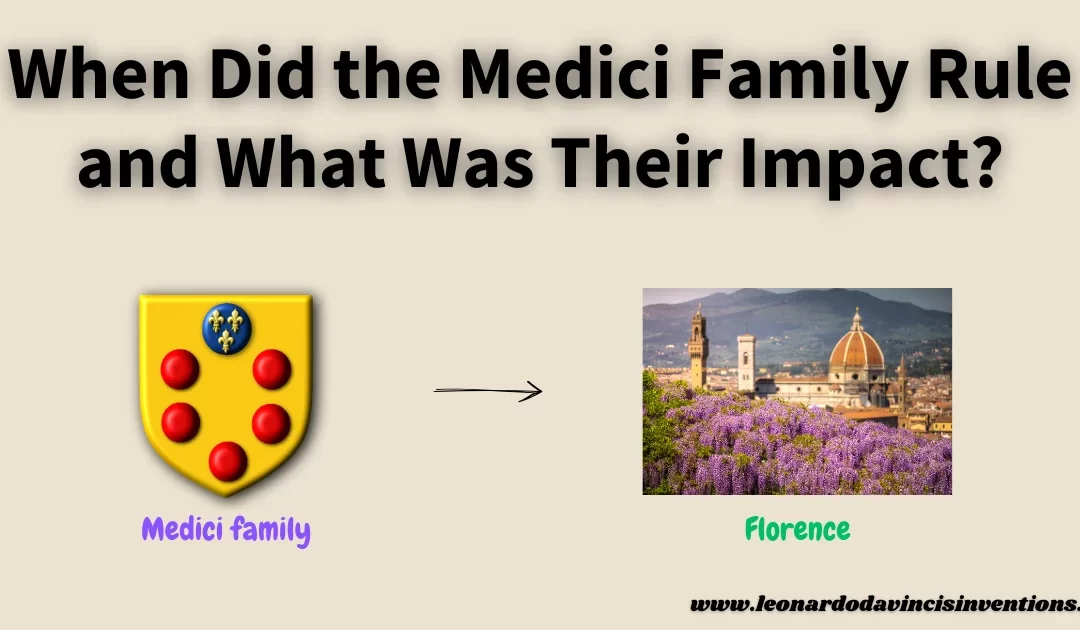
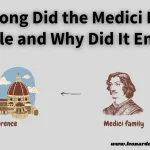
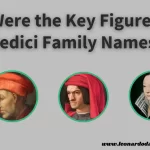

 Leonardo Bianchi,
the creator of Leonardo da Vinci's Inventions.
Thank you for visiting
Leonardo Bianchi,
the creator of Leonardo da Vinci's Inventions.
Thank you for visiting